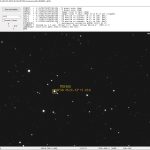
Project Gallery 2023
Secondary students from across Europe became exoplanet detectives with ESA and used Cheops satellite data to uncover the mysteries of two exoplanet targets: KELT-3b and TOI-560c.
Explore the projects below.
ASTROLUBUL BUCURESTI ROMANIA
Best Project Prize Winner
ASTROCLUBUL BUCURESTI BUCHAREST – Romania 16 years old, 18 years old, 15 years old 4 / 3
TOI-560c
TOI-560c project description:
TOI-560c is the second exoplanet orbiting TOI-560 (HD 73583), a K dwarf star located at 103.05 light years from the Earth. The light curve of this star obtained by Cheops satellite shows a transit with a depth of 0.11 %, and some stellar variability. Based on the transit depth formula we found a radius of 2.371×REarth. Thus, we can classify it as a ‘Mini-Neptune’. Considering the period of the transits (18.8797 days), we calculated the semi-major axis of 0.124 AU.
The temperature of the planet TOI560-c is 225±15 °C and its distance to the star, suggest that it is very unlikely to have liquid water at the surface. As a consequence, it is impossible for it to host life similar to life on Earth.
We calculated a density of 3.99 g/cm³, using its mass (~9,70* MEarth) and its volume of 1,44926 × 10²⁸ cm³. This corresponds to a rocky planet. TOI-560c’s density is similar to Mars’ density, so it is possible that it also has a composition like Mars: magnesium, silicon, iron, nickel, and sulfur. The iron oxide could give a red color to this planet.
Taking into account that TOI-560c is very close to the star, it is also subject to a very high level of radiation, so it is not habitable.
TOI-560c Results and Analysis
Based on the transit depth formula (transit depth(“%” )≈(π×〖Rp〗^2)/(π×〖Rs〗^2 )×100) we found a radius of TOI-560c = 2.371×REarth. Thus, we can classify it as a ‘Mini-Neptune’.
Considering the period of the transits (it has a short orbital period of 18.8797 days), we can apply the Kepler’s third law (T^2=(4π^2)/GMs×d^3) and we calculated the semi-major axis of 0.124 AU (astronomical units).
Based on the information received that the temperature of TOI-560c is 225±15 °C, too hot to have liquid water, we draw the conclusion that it is impossible for it to host life similar to life on Earth.
We calculated the exoplanet density = 3.99 g/cm³, using its mass (~9,70 MEarth) and its volume (V=4/3 πR^3) of 1,44926 × 10²⁸ cm³ along with the formula (ρ=M/V). This corresponds to a rocky planet, similar to Mars.
Note 1: Location of TOI-560 (HD 73583) star in the sky according to Stellarium Web (see attached photo)
Note 2: We shot few photos of TOI-560 with a remote telescope AUS-2-CMOS (Telescope Live Network) (see attached photo; software used: ASTAP).
TOI-560c Conclusions
TOI-560c exoplanet:
– is a mini-Neptune planet (similar radius to Neptune)
– it’s orbit around the star is at 0.124 AU, very close, so it is hot and affected by radiation.
– it is not habitable (with lifeforms as those on Earth) because there is probably no liquid water and the level of radiation is too high
– density is 3.99 g/cm^3, similar to density of Mars, and because of this similarity, it is possible that it also has a composition like Mars . It may be composed of magnesium, silicon, iron, nickel and sulfur, and it is also likely that it could have the same color as Mars as a result of the oxidation of iron on the surface.
The next three transits of the planet, observable from Bucharest, Romania, at over 20° altitude above horizon in the sky, will be on 22 November 2023, 10 and 29 December 2023. Thus, we are planning to collect additional data, in order to refine the values presented here. (according to Exoplanet Transit Database; http://var2.astro.cz/ETD/predict_detail.php?delka=45&submit=submit&sirka=26&STARNAME=TOI-560&PLANET=c )
Supporting files:



